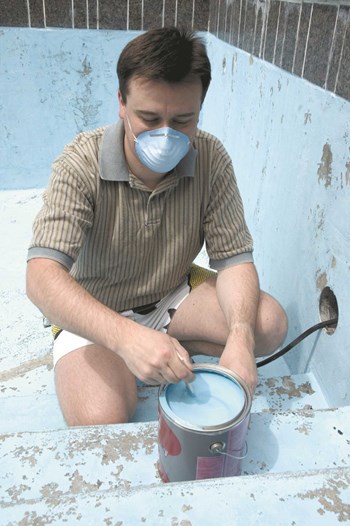
Visions of lounging by the pool on a hot July weekend lure many homebuyers into the condominium lifestyle. For families, the attraction may include use of their own, “private,” playground, swing set, tennis court or patio for cookouts. But warm weather activities in New England have a short season, followed by famously unforgiving winters.
Outdoor-fun facilities and equipment take a beating every year and for managers, getting them up to snuff every spring seems like a never-ending battle. But it’s a battle that cannot be avoided. Between property values—perceived or real—and liability/safety issues, the outdoor amenities that grace many communities demand attention every spring. And even though they may be considered extraneous luxuries, they’re not likely to go away.
“In the 1980s, a lot of developers put pools in,” notes Brandon Whitman, owner of Lionheart Contracting of Franklin, Massachusetts. “But it can be a hairy situation [for the budget] to support a pool, for a middle-income, 30-unit property. I’ve seen an association close the pool for just one season to save money, but if it’s a deeded amenity, the board cannot just close it down…”
“I recommend that the earlier you start to get the pool ready to open, the better, since you never know for sure what you’re going to get. The process should start by April 15 if pool opening is scheduled for May 15,” Whitman states. “I’ve seen a case where a very well-to-do community rushed to open their pool, not taking enough time to check all surfaces. Turns out, there was a crack at the bottom that wasn’t attended to, and thousands of gallons of water seeped out every day.” Pressure to keep the pool open meant that the leak wasn’t investigated or repaired until the season was over.
Whitman warns that “the pool industry is very complicated. In Massachusetts, the local board of health or health agent issues a permit each year, and their inspection should be scheduled at least two weeks before opening. The agent could give you 20 things to do before you can open the pool.”
Because regulations are so strict, especially regarding pool sanitation and the associated chemicals, larger communities with a pool often include a CPO [certified pool operator] among their staff, or a management company provides one. Whitman reports, “Sometimes an association relies on a chemical supply company to provide the CPO service, but our company can save up to 40 percent on chemical bills when we manage the pool for them.” In addition to general property management, Lionheart Contracting specializes in a full range of pool management services including lifeguards.
To complicate pool management, there is no standard formula for pool chemicals. Whitman points out, “You apply chemicals according to the specific site and the local environment.” There are many choices of products, including chlorine, bromine and salt systems. The reading used in daily pool testing is measuring a chlorine compound that’s a by-product of the sanitizing action.
The other element of sanitization is mechanical filtering, with systems using sand or diatomaceous earth [DE]. “These systems involve piping, pumps and motors that need to be checked before pool opening. Without proper filtration, the chemicals may test out okay, even though there is particulate clouding the water,” Whitman says. “A turbid pool might look blue because of the chemicals, so it looks right even though it is cloudy… it tricks your eye and you think you’re seeing the blue pool bottom,” when it’s actually blue reflecting from the chemicals and particulate. This illusion of clarity, he adds, may explain the tragic situation that occurred this summer when a drowned woman was discovered in the bottom of a municipal pool in Massachusetts.
In addition to the issue of pool sanitation is the physical layout of the pool area. “Pool decking can move and become a trip hazard,” Whitman says. It must be inspected each spring, along with the pool liner. He adds that in recent years community pools have scrapped diving boards and are being constructed—or rebuilt--to eliminate deep ends, to create a maximum depth of four feet.
Love-Hate Relationship with Amenities
In Woburn, Massachusetts, American Properties Team president Deborah Jones agrees that pool upkeep is a high-priced challenge for condo boards. “It’s a short season for such an expensive amenity,” she states, “but I have seen a pool remain open even when tennis courts fall out of repair. It still adds to unit values. I haven’t seen any properties where the owners voted it out [to save money]… and it would take a vote of all owners to delete an amenity like that. I still see pools being built at new developments.”
The biggest challenge for prepping common spaces after winter ends, she says, is timing. “The winters are so long and tedious, people want to see their properties beautiful immediately. Sometimes weather prevents you from starting cleanup—so you have to make sure that contractors are lined up by the previous fall.”
“Early” is the buzzword for pavement maintenance too, she adds. “Paved areas need regular inspection, especially early in spring, because the material cures better if it’s not hot out. You need to have a crack-filling program” to stay ahead of water infiltration. “Have an engineer check all old pavement,” Jones suggests, since entire stretches of roadway may need rebuilding if not maintained properly, on a schedule.
While many developers pushed “over-55” adult communities during the most recent real estate boom, plenty of community associations are comprised of larger units that accommodate young families. These properties cater to parents and children with areas for sports and games, playground equipment and outdoor furniture such as benches and picnic tables.
Meghan O’Brien is president of M.E. O’Brien & Sons of Medfield, Massachusetts, a company that provides and maintains site furnishings—including fencing, playground equipment and benches—in all six New England states. She stresses the importance of durability with all outdoor structures.
“We’ve had [playground] clients who paid a lot for duds that cracked and broke apart,” she says. “You definitely want a product that’s good for at least 20 years, although you still have to check after the winter, where maintenance is required [each season] on the playground surfaces.
“About 75 percent of all playground accidents are from [neglected] fill on the ground surface.” She explains that the most popular surface today is engineered wood fiber. “It’s virgin hardwood that’s fabricated into chips of varied sizes, so it compacts firmly—it threads itself together and does not move around. We like to install 16 inches which compacts to 12 inches with foot traffic and the weather, and you can top it off over the years. This will ensure good impact attenuation, which is how well the material absorbs shock from a fall, especially from an elevated height.”
Another material for surfaces is poured-in-place rubber, O’Brien states. “This is a two-coat process… the bottom layer is one to five inches thick and acts as the absorption layer. It can be installed over pavement or crushed stone. The top layer is about a half-inch of poured, granulated material that’s much denser for wear, and it can be colored—even with graphics, and it’s UV stable to withstand sunlight. This method is more expensive but it will last for years with no topping off, just an occasional power-wash. It’s very low-maintenance.”
Much outdoor and play equipment is now manufactured from recycled plastics. “We also see a lot of glass fiber reinforced concrete [GFRC],” O’Brien notes. “It’s used for man-made rocks or log tunnels for kids to climb. Actual wood lumber hasn’t been used in recent years, mainly because the market and pricing is so unstable. Plus, I’ve seen lawsuits that had to deal with splinters.”
One very cost-effective material is polycarbonate “which can look just like concrete, and is used in planters, benches and trash receptacles,” adds O’Brien. “Benches can also be made of steel, other kinds of recycled plastic, and we see teak on occasion. Teak can be rubbed with teak oil for a honey color, but it really needs no maintenance…it will last 75 years untreated.”
When Amenities Become Controversial
Attorney Frank Lombardi, a partner in the law firm of Goodman, Shapiro & Lombardi of Dedham, Massachusetts, warns that “when you fail to maintain [facilities], that’s defined as negligence. Look at it from your insurance agent’s point of view. If you don’t upgrade your playground, the swing set will rust or fall apart. A playground is an ‘attractive nuisance’… If you’re not going to maintain it, get rid of it.
“With a pool, you can’t just get rid of it, and it can get downgraded to the point where it needs a complete replacement. I have seen an example, with one property that had a large pool, built in the 1970s. The association proceeded to do simple patch jobs for over 30 years. Their contractors warned, ‘all we’re doing is patching’ so experts were hired who said the pool needed a major overhaul. The board finally went ahead and acted on those recommendations, even though many residents were not in favor. They went ahead with a complete replacement, rebuilding a new pool in the shell of the old one, making it smaller and eliminating the diving board and deep section. A group of unit owners resisted, insisting that a loan to finance the job was frivolous, and they tried to remove the board members.
“We did our due diligence, however,” Lombardi continues, “with a three-hour presentation that projected the numbers out for the next ten years… We proved that after spending $5,000 each year… it will add up to $150,000 over the next ten years to patch the old pool, then it will still have to be replaced, just to meet code requirements. Doing the capital improvement now instead of later, meant an all-over improved facility, with better fencing and added security… even an upgraded pool patio surface.”
He points out that boards try to save money with cheaper, short-term patch jobs when a capital improvement to outdoor amenities is actually more cost-effective. “You have to ‘do the math,” says Lombardi, “and get everyone to see the numbers” that illustrate the advantages of proper, long-term maintenance. Even as some unit owners grumble about the cost of maintaining amenities that they no longer use, most residents see the added value of pools, playgrounds and other very-visible features that ultimately enhance their community, and they’d be hard-put to give them up.
Marie Auger is a Massachusetts freelance writer and a frequent contributor to New England Condominium.






Leave a Comment